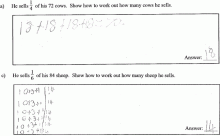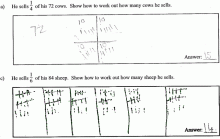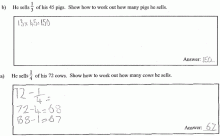Farm fractions

A farmer is selling some of his animals.
a) He sells 14 of his 72 cows. Show how to work out how many cows he sells.
|
Answer: __________
|
b) He sells 13 of his 45 pigs. Show how to work out how many pigs he sells.
|
Answer: __________
|
c) He sells 16 of his 84 sheep. Show how to work out how many sheep he sells.
|
Answer: __________
|
This resource can help to identify students' understanding of fractions as operators. Students' strategies give a better indication of curriculum level and progress than their answer.
At level 3 students start to use multiplication and division facts, and simple multiplicative strategies to find common fractions of quantities (e.g., for 1/4 of 24, involve recognising that 4 lots of 6 make 24, so 1/4 of 24 is 6. A possible progression for understanding could involve:
- using counting or grouping strategies to correctly solve the fraction problems
- using additive strategies such as repeated addition to correctly solve the fraction problems
- using a halving strategy to correctly solve these fraction problems
- using reverse multiplication and division strategies to correctly solve the fraction problems.
| Y7 (05/2010) | ||
| a) |
18 Working involving:
|
moderate |
| b) |
15 Working as above involving part-whole splitting, dividing the whole number by the denominator, short division, reverse multiplication, repeated addition, trial and improvement, and counting into groups. |
moderate |
| c) |
14 |
difficult |
NOTE: The main focus for the working part of these questions is on the use of an appropriate strategy i.e., the communication of the attempted calculation as well as a stepwise sequence that could lead to a correct answer.
This resource is about fractions as operators which can be seen as a different "personality" of fractions. This involves an understanding that a fraction can act as an operation upon a number (in this case a whole number). The number is treated as the whole of which to find the fraction. Ideally, this idea follows on from the understanding that fractions represent part-whole relationships (part-whole understanding of fractions), and these problems can be solved by identifying the part and the whole. Fraction-operator questions can be of two forms: find the whole given the part and find the part given the whole. These questions were all of the type, find the part given the whole.
Prior knowledge
Students should have an understanding of fractions as part-whole relationships for regions, sets and whole numbers.
Students used a range of multiplicative, additive and counting strategies to answer these questions. A number of students also used "whole number" strategies to attempt to solve these maths problems. This misconception involves treating the numerator and the denominator as separate whole numbers and either subtracting or multiplying to get a wide range of answers.
| Common error | Likely misconception | |
|
a) b) c) |
62 35 74 |
Whole number misconception Students know that finding a fraction of a number involves reducing the number , but they lack understanding of how to apply fraction as an operator, so attempt to treat the fraction as a whole number and subtract - in this case the value of 10 - some kind of place value interpretation of fractions. |
|
a) b) c) |
16, 17, 19, or 20 13, 14, 16 12, 13, 15, or 16 |
Calculation error Students are likely to have miscalculated when solving the fraction problem. These errors are out by +/- 1 or 2. This is likely to be a part of a counting strategy. |
Student work samples
Student exemplars including reverse multiplication and division strategies, trial and error, halving and doubling, repeated addition, counting or grouping strategies, and whole number misconceptions of fractions.
Insufficient or incomplete working
Students who showed insufficient or no working may have not experienced the need for working or not believe it is important to show working if they know the answer. Developing the ability to make a mathematical statement (such as how they worked it out) is a valid part of the mathematics learning. It can also provide significant formative information about their learning needs.
Students who showed their working as repeating or summarising information (e.g., 1/4 x 72) from the question may need to discuss what constitutes working (or an argument), or even that working is their rationale for their answer. Students could share their working and identify if it is sufficiently explicit to be a justification for the answer they have given. As the use of multiple strategies is an important aspect of contemporary mathematics pedagogy (as well as a key indicator of an advanced stage in the Number Framework), value needs to be placed on encouraging students to communicate their strategies, both orally (see whole class discussion), and in writing.
Cannot work out fractions of a whole number (used whole number strategies)
Students who worked out other incorrect solutions to the problems may need to look at more basic fraction problems and smaller whole numbers that can be modelled by counters as required, e.g., 3/4 of 12, 1/5 of 15, and If 2/3 is 6 what is a whole? Student could also look at Fraction soup animation. or Finding the fraction of things. See Fraction thinking concept map: Fractions as operators.
Strategies - Appendix Numbers of students who answered with strategies that could lead to correct solutions
| Questions | ||||
| a) | b) | c) | overall accuracy across 3 questions | |
| Part-whole splitting of the numbers | 8 (5) | 9 (8) | 9 (8) | = (21)/26 = 81% |
| Dividing by the denominator | 13 (8) | 19 (13) | 16 (11) | = (32)/48 = 67% |
| Short division | 17 (15) | 18 (16) | 19 (17) | = (48)/54 = 89% |
| Reverse multiplication | 13 (10) | 12 (10) | 10 (3) | = (23)/35 = 66% |
| Halving and doubling | 33 (27)* | 7 (0)* | 7 (0)* | = (27)/47 = 57% |
| Repeated addition | 6 (4) | 13 (11) | 6 (3) | = (18)/25 = 72% |
| Counts out into groups | 14 (6) | 13 (9) | 10 (4) | = (19)/37 = 51% |
| Trial and improvement | 4 (1) | 3 (3) | 8 (6) | = (10)/15 = 67% |
NOTE: the number in brackets is the number of correct answers for that strategy. *When used appropriately halving and doubling had 82% accuracy. It was not a sufficient strategy for questions b) and c).
To look at animations that explore finding fractions of a set, see Fraction Soup or Toy holiday (Level 3).
Numeracy resources
Book 7: Teaching Fractions, Decimals and Percentages, 2006:
Birthday Cakes
Fractional Blocks
- Sharing Easter eggs
- Buying Christmas presents
- Food fractions
- Food fractions II
- Cookie monster
- Hungry shark
- Soccer season
- Model car fractions
- Counters and fractions
- Money fractions
- Fractions of money
- Fraction Soup
- Toy holiday
- Food for the day
- Fractions and sets
- Building percentages
- Shading fractions of sets and shapes
- Fruit Salad













